Theories of Cultural Competence: An Intercultural Communication Essay
VerifiedAdded on 2022/11/13
|9
|2536
|289
Essay
AI Summary
This essay delves into the crucial concept of cultural competence within the context of intercultural communication, particularly in a globalized workplace. It begins by defining cultural competence as the ability to effectively interact with people from diverse cultural backgrounds, emphasizing respect for differences and facilitating seamless communication. The essay highlights the benefits of a culturally competent workplace, including increased productivity, improved employee working conditions, reduced conflict, and enhanced collaboration. It explores the importance of both verbal and nonverbal communication in intercultural settings, emphasizing the two-way nature of effective cross-cultural interactions. The essay then examines three key theories of competence: the Multicultural Personality Questionnaire (MPQ), the Intercultural Developmental Inventory (IDI), and the Cultural Intelligence Scale (CQS), discussing their strengths and limitations in assessing intercultural traits, attitudes, and capabilities. The importance of intercultural traits, attitudes, and cultural intelligence in fostering positive interactions and understanding is also discussed. The essay concludes by emphasizing the significance of cultural competence in today's globalized world, highlighting its relevance in various fields, including government and military, and its role in promoting harmonious environments and effective organizational management. The author also provides a personal reflection on their experience with intercultural interactions, emphasizing the importance of openness, flexibility, and embracing cultural differences.
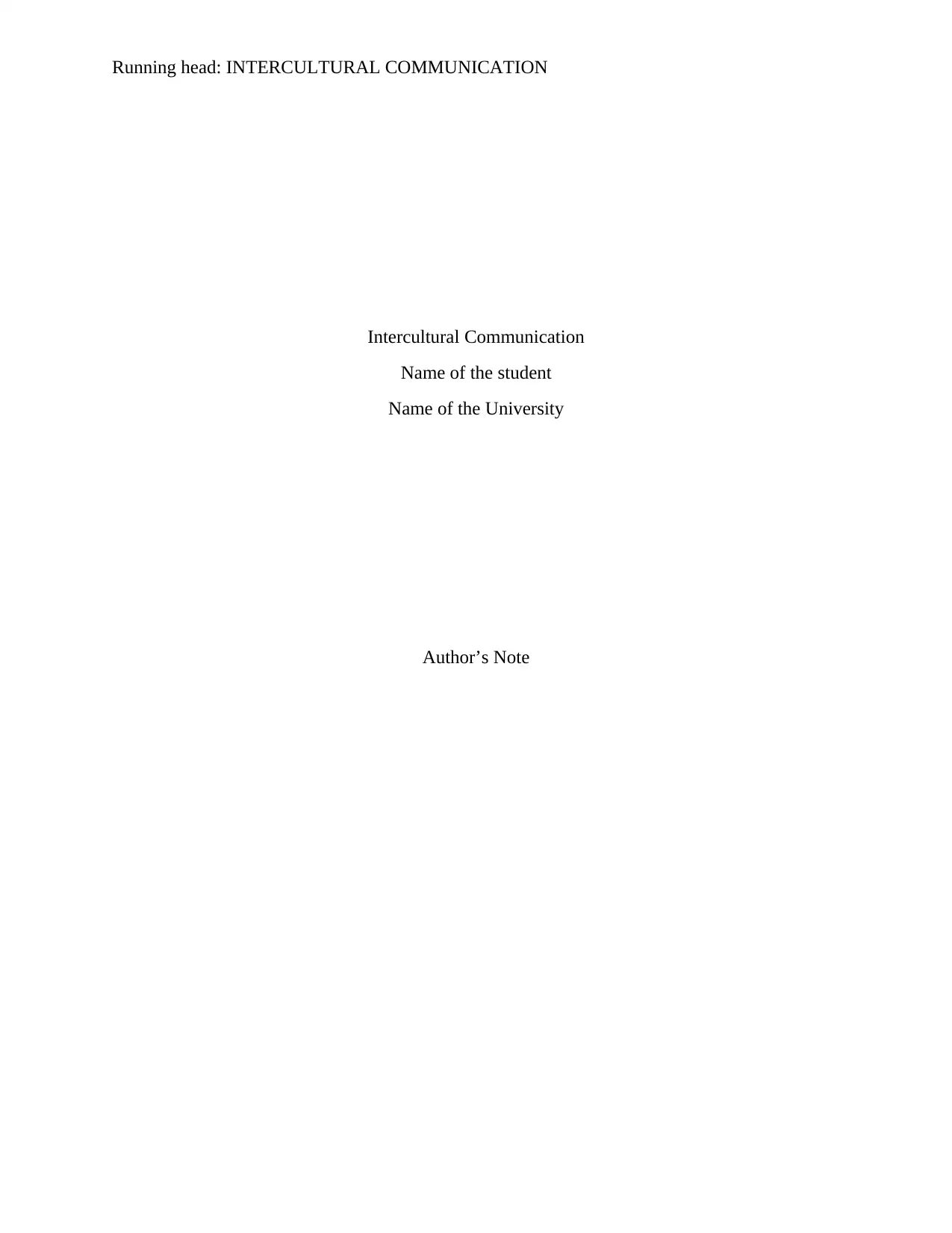
Running head: INTERCULTURAL COMMUNICATION
Intercultural Communication
Name of the student
Name of the University
Author’s Note
Intercultural Communication
Name of the student
Name of the University
Author’s Note
Paraphrase This Document
Need a fresh take? Get an instant paraphrase of this document with our AI Paraphraser
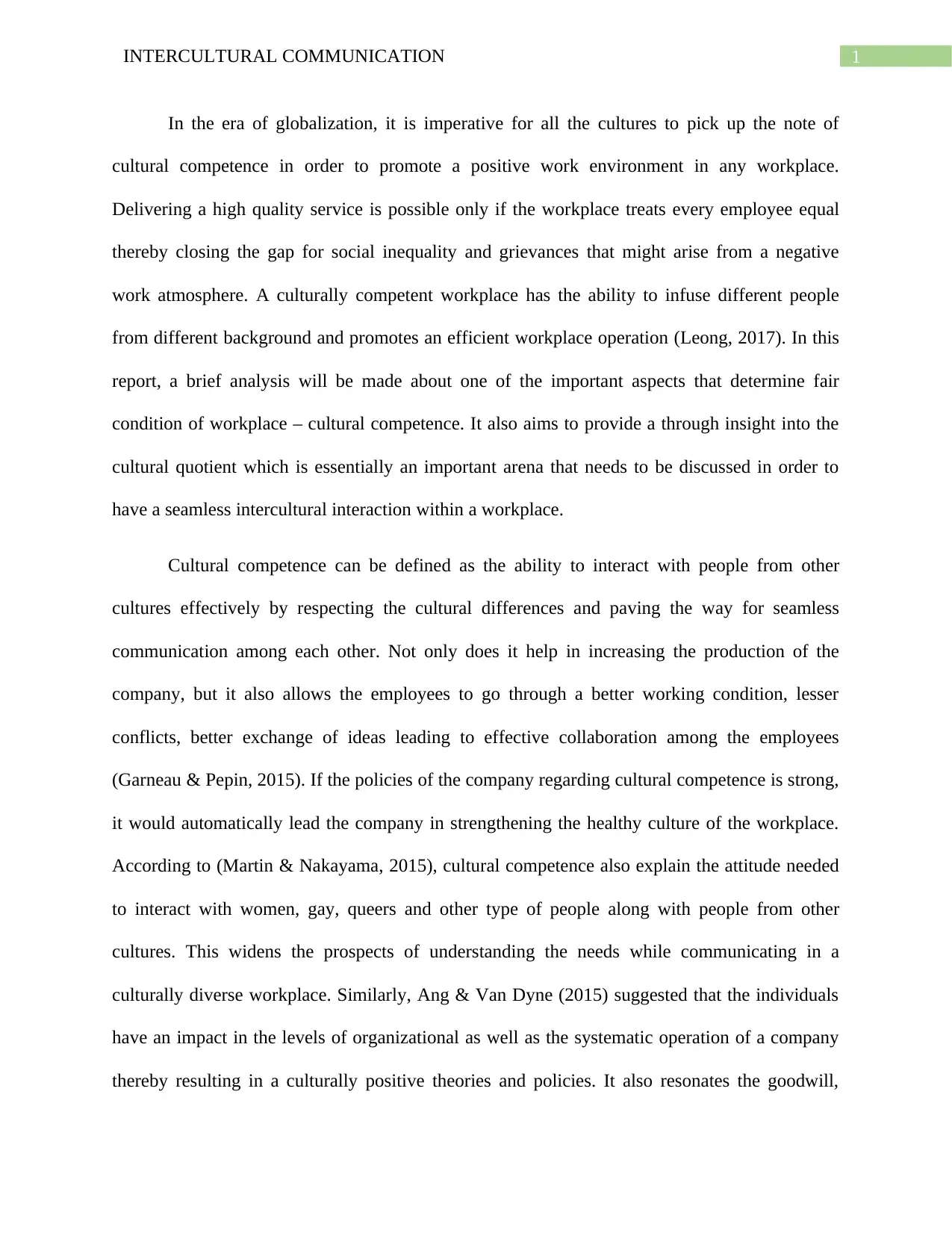
1INTERCULTURAL COMMUNICATION
In the era of globalization, it is imperative for all the cultures to pick up the note of
cultural competence in order to promote a positive work environment in any workplace.
Delivering a high quality service is possible only if the workplace treats every employee equal
thereby closing the gap for social inequality and grievances that might arise from a negative
work atmosphere. A culturally competent workplace has the ability to infuse different people
from different background and promotes an efficient workplace operation (Leong, 2017). In this
report, a brief analysis will be made about one of the important aspects that determine fair
condition of workplace – cultural competence. It also aims to provide a through insight into the
cultural quotient which is essentially an important arena that needs to be discussed in order to
have a seamless intercultural interaction within a workplace.
Cultural competence can be defined as the ability to interact with people from other
cultures effectively by respecting the cultural differences and paving the way for seamless
communication among each other. Not only does it help in increasing the production of the
company, but it also allows the employees to go through a better working condition, lesser
conflicts, better exchange of ideas leading to effective collaboration among the employees
(Garneau & Pepin, 2015). If the policies of the company regarding cultural competence is strong,
it would automatically lead the company in strengthening the healthy culture of the workplace.
According to (Martin & Nakayama, 2015), cultural competence also explain the attitude needed
to interact with women, gay, queers and other type of people along with people from other
cultures. This widens the prospects of understanding the needs while communicating in a
culturally diverse workplace. Similarly, Ang & Van Dyne (2015) suggested that the individuals
have an impact in the levels of organizational as well as the systematic operation of a company
thereby resulting in a culturally positive theories and policies. It also resonates the goodwill,
In the era of globalization, it is imperative for all the cultures to pick up the note of
cultural competence in order to promote a positive work environment in any workplace.
Delivering a high quality service is possible only if the workplace treats every employee equal
thereby closing the gap for social inequality and grievances that might arise from a negative
work atmosphere. A culturally competent workplace has the ability to infuse different people
from different background and promotes an efficient workplace operation (Leong, 2017). In this
report, a brief analysis will be made about one of the important aspects that determine fair
condition of workplace – cultural competence. It also aims to provide a through insight into the
cultural quotient which is essentially an important arena that needs to be discussed in order to
have a seamless intercultural interaction within a workplace.
Cultural competence can be defined as the ability to interact with people from other
cultures effectively by respecting the cultural differences and paving the way for seamless
communication among each other. Not only does it help in increasing the production of the
company, but it also allows the employees to go through a better working condition, lesser
conflicts, better exchange of ideas leading to effective collaboration among the employees
(Garneau & Pepin, 2015). If the policies of the company regarding cultural competence is strong,
it would automatically lead the company in strengthening the healthy culture of the workplace.
According to (Martin & Nakayama, 2015), cultural competence also explain the attitude needed
to interact with women, gay, queers and other type of people along with people from other
cultures. This widens the prospects of understanding the needs while communicating in a
culturally diverse workplace. Similarly, Ang & Van Dyne (2015) suggested that the individuals
have an impact in the levels of organizational as well as the systematic operation of a company
thereby resulting in a culturally positive theories and policies. It also resonates the goodwill,
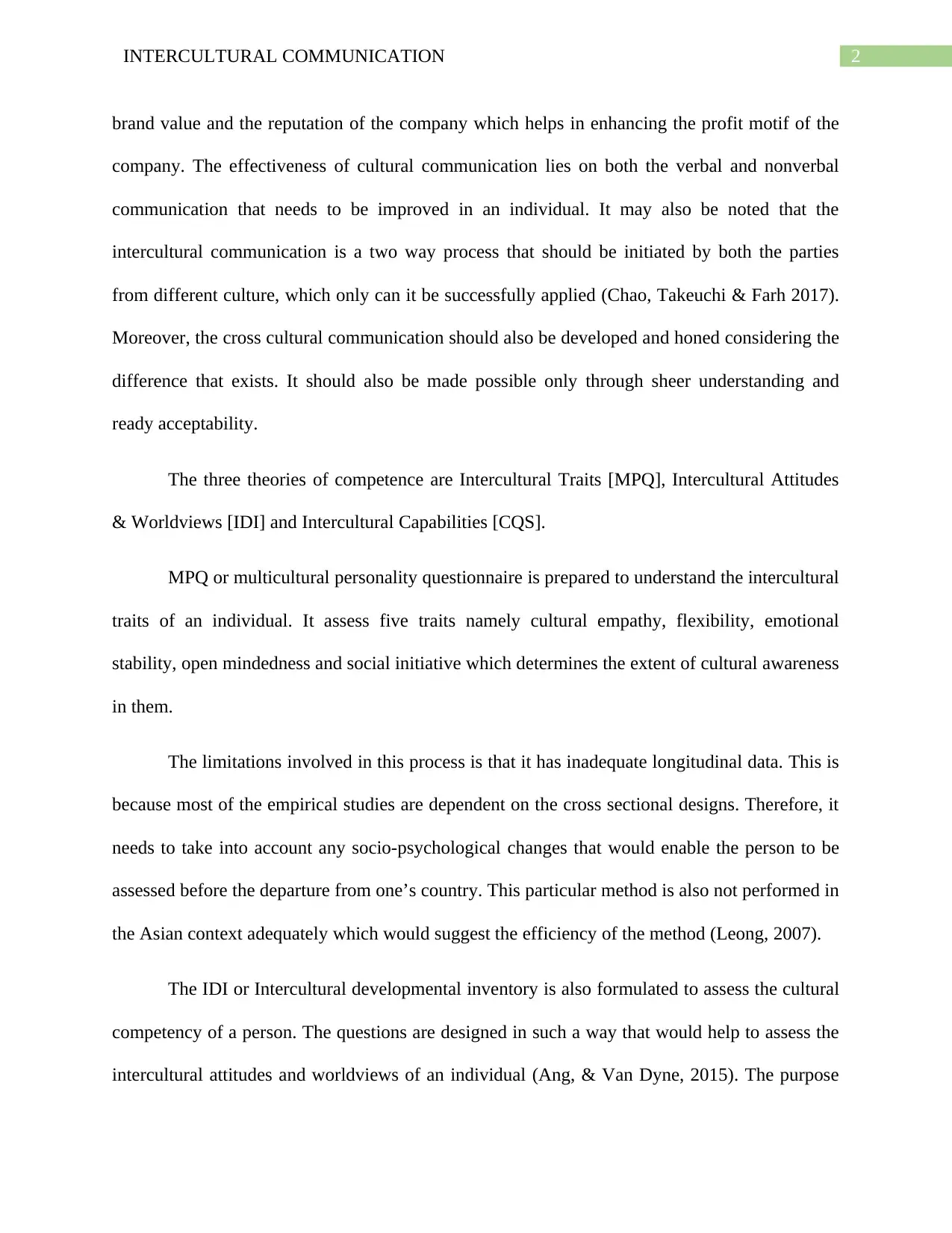
2INTERCULTURAL COMMUNICATION
brand value and the reputation of the company which helps in enhancing the profit motif of the
company. The effectiveness of cultural communication lies on both the verbal and nonverbal
communication that needs to be improved in an individual. It may also be noted that the
intercultural communication is a two way process that should be initiated by both the parties
from different culture, which only can it be successfully applied (Chao, Takeuchi & Farh 2017).
Moreover, the cross cultural communication should also be developed and honed considering the
difference that exists. It should also be made possible only through sheer understanding and
ready acceptability.
The three theories of competence are Intercultural Traits [MPQ], Intercultural Attitudes
& Worldviews [IDI] and Intercultural Capabilities [CQS].
MPQ or multicultural personality questionnaire is prepared to understand the intercultural
traits of an individual. It assess five traits namely cultural empathy, flexibility, emotional
stability, open mindedness and social initiative which determines the extent of cultural awareness
in them.
The limitations involved in this process is that it has inadequate longitudinal data. This is
because most of the empirical studies are dependent on the cross sectional designs. Therefore, it
needs to take into account any socio-psychological changes that would enable the person to be
assessed before the departure from one’s country. This particular method is also not performed in
the Asian context adequately which would suggest the efficiency of the method (Leong, 2007).
The IDI or Intercultural developmental inventory is also formulated to assess the cultural
competency of a person. The questions are designed in such a way that would help to assess the
intercultural attitudes and worldviews of an individual (Ang, & Van Dyne, 2015). The purpose
brand value and the reputation of the company which helps in enhancing the profit motif of the
company. The effectiveness of cultural communication lies on both the verbal and nonverbal
communication that needs to be improved in an individual. It may also be noted that the
intercultural communication is a two way process that should be initiated by both the parties
from different culture, which only can it be successfully applied (Chao, Takeuchi & Farh 2017).
Moreover, the cross cultural communication should also be developed and honed considering the
difference that exists. It should also be made possible only through sheer understanding and
ready acceptability.
The three theories of competence are Intercultural Traits [MPQ], Intercultural Attitudes
& Worldviews [IDI] and Intercultural Capabilities [CQS].
MPQ or multicultural personality questionnaire is prepared to understand the intercultural
traits of an individual. It assess five traits namely cultural empathy, flexibility, emotional
stability, open mindedness and social initiative which determines the extent of cultural awareness
in them.
The limitations involved in this process is that it has inadequate longitudinal data. This is
because most of the empirical studies are dependent on the cross sectional designs. Therefore, it
needs to take into account any socio-psychological changes that would enable the person to be
assessed before the departure from one’s country. This particular method is also not performed in
the Asian context adequately which would suggest the efficiency of the method (Leong, 2007).
The IDI or Intercultural developmental inventory is also formulated to assess the cultural
competency of a person. The questions are designed in such a way that would help to assess the
intercultural attitudes and worldviews of an individual (Ang, & Van Dyne, 2015). The purpose
⊘ This is a preview!⊘
Do you want full access?
Subscribe today to unlock all pages.

Trusted by 1+ million students worldwide
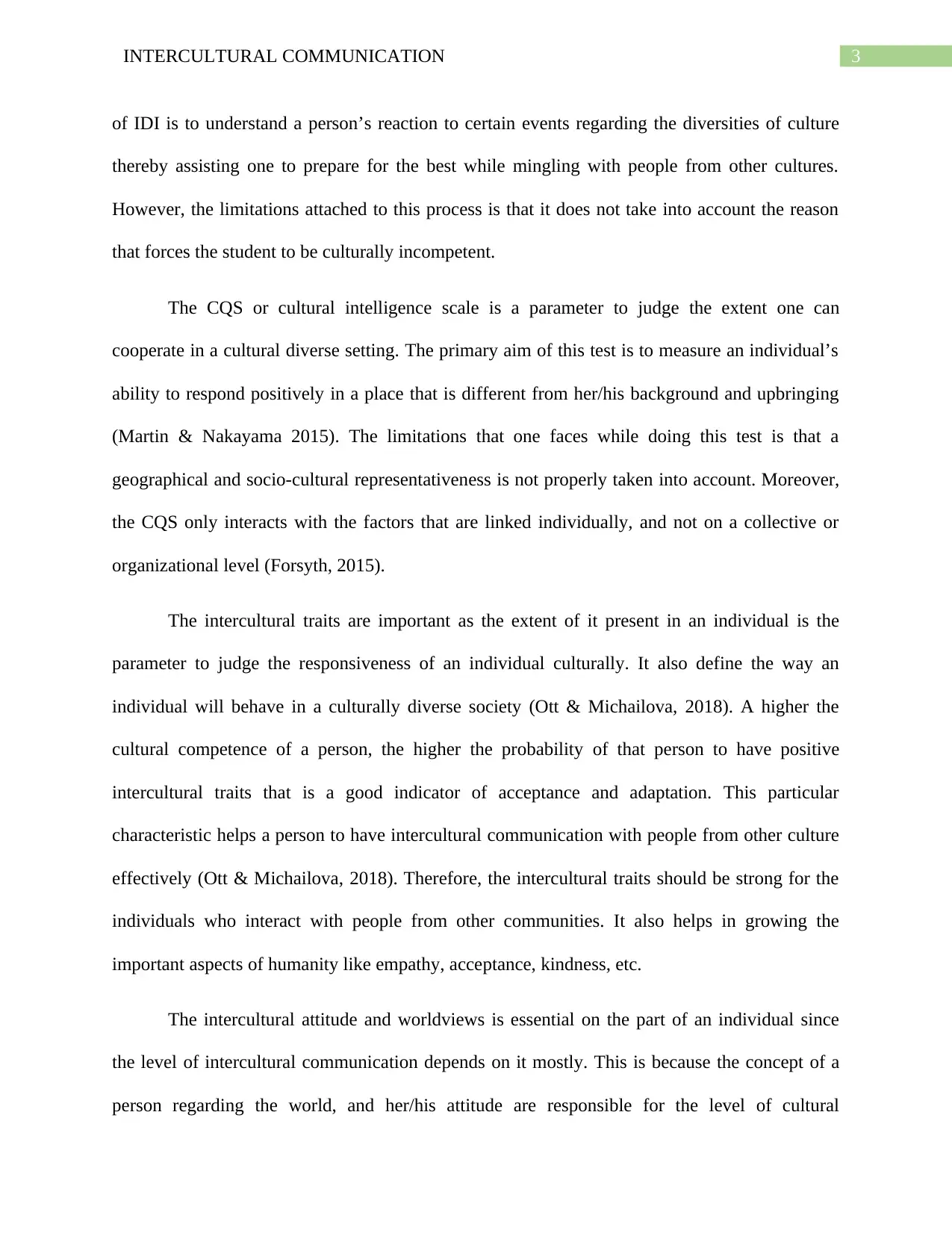
3INTERCULTURAL COMMUNICATION
of IDI is to understand a person’s reaction to certain events regarding the diversities of culture
thereby assisting one to prepare for the best while mingling with people from other cultures.
However, the limitations attached to this process is that it does not take into account the reason
that forces the student to be culturally incompetent.
The CQS or cultural intelligence scale is a parameter to judge the extent one can
cooperate in a cultural diverse setting. The primary aim of this test is to measure an individual’s
ability to respond positively in a place that is different from her/his background and upbringing
(Martin & Nakayama 2015). The limitations that one faces while doing this test is that a
geographical and socio-cultural representativeness is not properly taken into account. Moreover,
the CQS only interacts with the factors that are linked individually, and not on a collective or
organizational level (Forsyth, 2015).
The intercultural traits are important as the extent of it present in an individual is the
parameter to judge the responsiveness of an individual culturally. It also define the way an
individual will behave in a culturally diverse society (Ott & Michailova, 2018). A higher the
cultural competence of a person, the higher the probability of that person to have positive
intercultural traits that is a good indicator of acceptance and adaptation. This particular
characteristic helps a person to have intercultural communication with people from other culture
effectively (Ott & Michailova, 2018). Therefore, the intercultural traits should be strong for the
individuals who interact with people from other communities. It also helps in growing the
important aspects of humanity like empathy, acceptance, kindness, etc.
The intercultural attitude and worldviews is essential on the part of an individual since
the level of intercultural communication depends on it mostly. This is because the concept of a
person regarding the world, and her/his attitude are responsible for the level of cultural
of IDI is to understand a person’s reaction to certain events regarding the diversities of culture
thereby assisting one to prepare for the best while mingling with people from other cultures.
However, the limitations attached to this process is that it does not take into account the reason
that forces the student to be culturally incompetent.
The CQS or cultural intelligence scale is a parameter to judge the extent one can
cooperate in a cultural diverse setting. The primary aim of this test is to measure an individual’s
ability to respond positively in a place that is different from her/his background and upbringing
(Martin & Nakayama 2015). The limitations that one faces while doing this test is that a
geographical and socio-cultural representativeness is not properly taken into account. Moreover,
the CQS only interacts with the factors that are linked individually, and not on a collective or
organizational level (Forsyth, 2015).
The intercultural traits are important as the extent of it present in an individual is the
parameter to judge the responsiveness of an individual culturally. It also define the way an
individual will behave in a culturally diverse society (Ott & Michailova, 2018). A higher the
cultural competence of a person, the higher the probability of that person to have positive
intercultural traits that is a good indicator of acceptance and adaptation. This particular
characteristic helps a person to have intercultural communication with people from other culture
effectively (Ott & Michailova, 2018). Therefore, the intercultural traits should be strong for the
individuals who interact with people from other communities. It also helps in growing the
important aspects of humanity like empathy, acceptance, kindness, etc.
The intercultural attitude and worldviews is essential on the part of an individual since
the level of intercultural communication depends on it mostly. This is because the concept of a
person regarding the world, and her/his attitude are responsible for the level of cultural
Paraphrase This Document
Need a fresh take? Get an instant paraphrase of this document with our AI Paraphraser
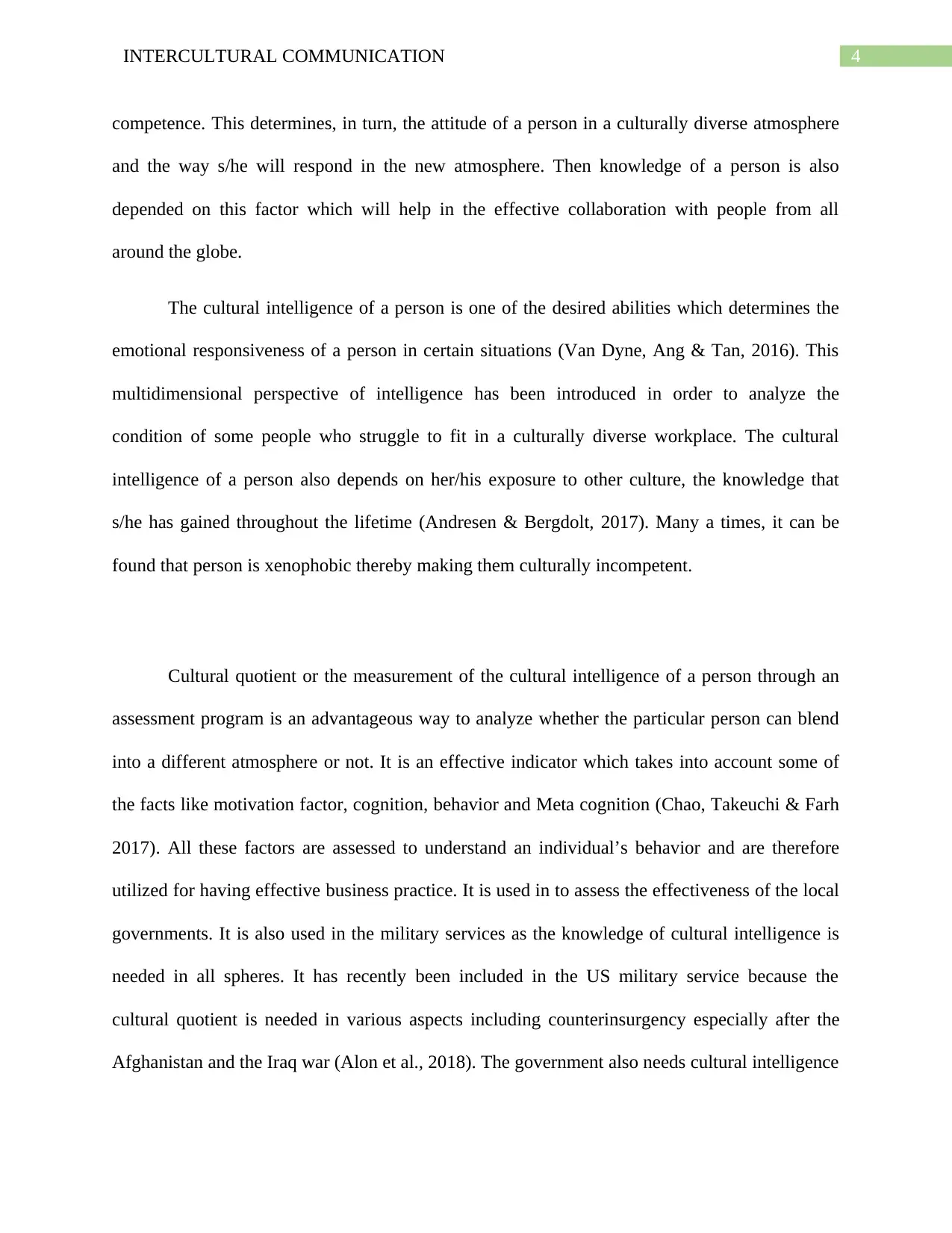
4INTERCULTURAL COMMUNICATION
competence. This determines, in turn, the attitude of a person in a culturally diverse atmosphere
and the way s/he will respond in the new atmosphere. Then knowledge of a person is also
depended on this factor which will help in the effective collaboration with people from all
around the globe.
The cultural intelligence of a person is one of the desired abilities which determines the
emotional responsiveness of a person in certain situations (Van Dyne, Ang & Tan, 2016). This
multidimensional perspective of intelligence has been introduced in order to analyze the
condition of some people who struggle to fit in a culturally diverse workplace. The cultural
intelligence of a person also depends on her/his exposure to other culture, the knowledge that
s/he has gained throughout the lifetime (Andresen & Bergdolt, 2017). Many a times, it can be
found that person is xenophobic thereby making them culturally incompetent.
Cultural quotient or the measurement of the cultural intelligence of a person through an
assessment program is an advantageous way to analyze whether the particular person can blend
into a different atmosphere or not. It is an effective indicator which takes into account some of
the facts like motivation factor, cognition, behavior and Meta cognition (Chao, Takeuchi & Farh
2017). All these factors are assessed to understand an individual’s behavior and are therefore
utilized for having effective business practice. It is used in to assess the effectiveness of the local
governments. It is also used in the military services as the knowledge of cultural intelligence is
needed in all spheres. It has recently been included in the US military service because the
cultural quotient is needed in various aspects including counterinsurgency especially after the
Afghanistan and the Iraq war (Alon et al., 2018). The government also needs cultural intelligence
competence. This determines, in turn, the attitude of a person in a culturally diverse atmosphere
and the way s/he will respond in the new atmosphere. Then knowledge of a person is also
depended on this factor which will help in the effective collaboration with people from all
around the globe.
The cultural intelligence of a person is one of the desired abilities which determines the
emotional responsiveness of a person in certain situations (Van Dyne, Ang & Tan, 2016). This
multidimensional perspective of intelligence has been introduced in order to analyze the
condition of some people who struggle to fit in a culturally diverse workplace. The cultural
intelligence of a person also depends on her/his exposure to other culture, the knowledge that
s/he has gained throughout the lifetime (Andresen & Bergdolt, 2017). Many a times, it can be
found that person is xenophobic thereby making them culturally incompetent.
Cultural quotient or the measurement of the cultural intelligence of a person through an
assessment program is an advantageous way to analyze whether the particular person can blend
into a different atmosphere or not. It is an effective indicator which takes into account some of
the facts like motivation factor, cognition, behavior and Meta cognition (Chao, Takeuchi & Farh
2017). All these factors are assessed to understand an individual’s behavior and are therefore
utilized for having effective business practice. It is used in to assess the effectiveness of the local
governments. It is also used in the military services as the knowledge of cultural intelligence is
needed in all spheres. It has recently been included in the US military service because the
cultural quotient is needed in various aspects including counterinsurgency especially after the
Afghanistan and the Iraq war (Alon et al., 2018). The government also needs cultural intelligence
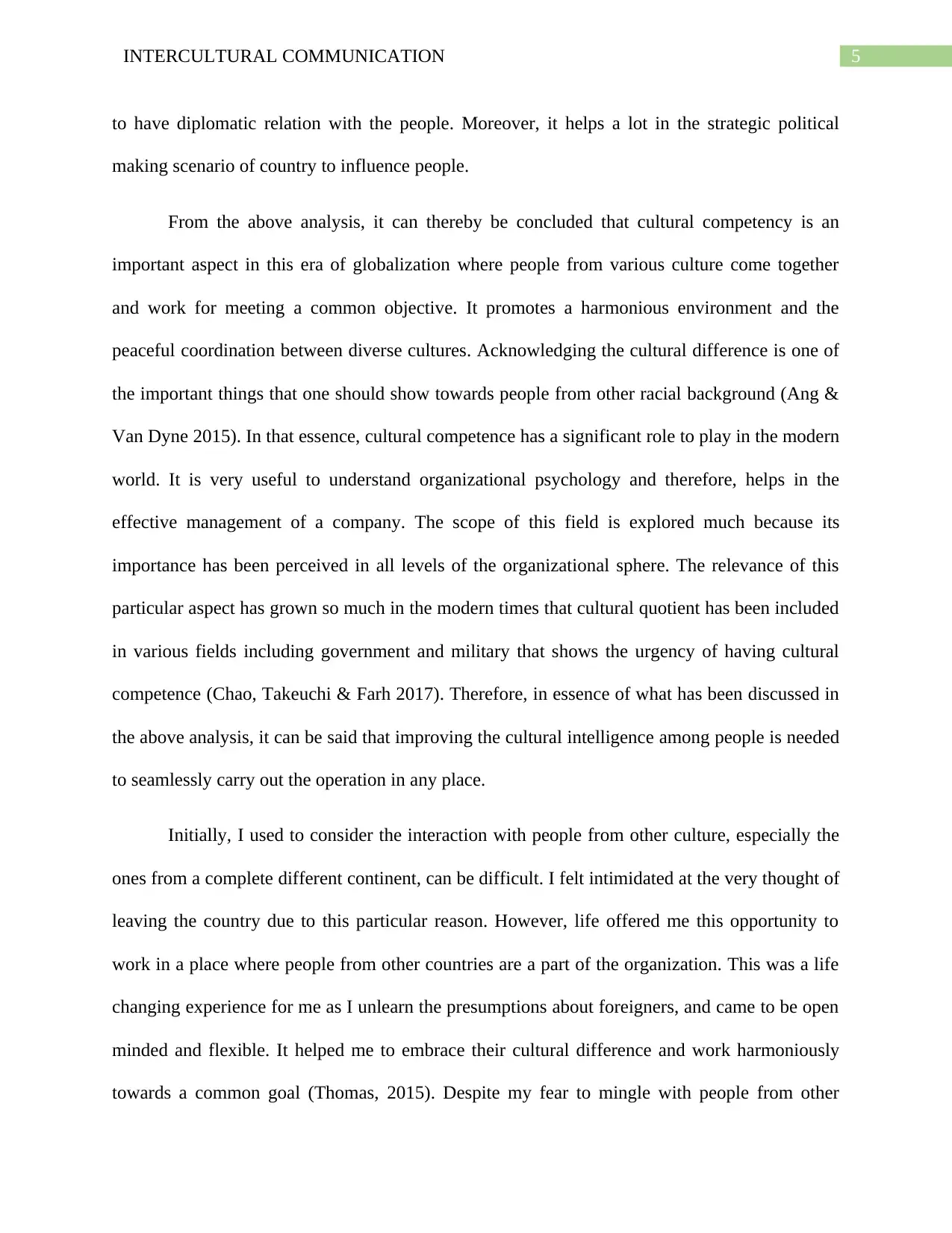
5INTERCULTURAL COMMUNICATION
to have diplomatic relation with the people. Moreover, it helps a lot in the strategic political
making scenario of country to influence people.
From the above analysis, it can thereby be concluded that cultural competency is an
important aspect in this era of globalization where people from various culture come together
and work for meeting a common objective. It promotes a harmonious environment and the
peaceful coordination between diverse cultures. Acknowledging the cultural difference is one of
the important things that one should show towards people from other racial background (Ang &
Van Dyne 2015). In that essence, cultural competence has a significant role to play in the modern
world. It is very useful to understand organizational psychology and therefore, helps in the
effective management of a company. The scope of this field is explored much because its
importance has been perceived in all levels of the organizational sphere. The relevance of this
particular aspect has grown so much in the modern times that cultural quotient has been included
in various fields including government and military that shows the urgency of having cultural
competence (Chao, Takeuchi & Farh 2017). Therefore, in essence of what has been discussed in
the above analysis, it can be said that improving the cultural intelligence among people is needed
to seamlessly carry out the operation in any place.
Initially, I used to consider the interaction with people from other culture, especially the
ones from a complete different continent, can be difficult. I felt intimidated at the very thought of
leaving the country due to this particular reason. However, life offered me this opportunity to
work in a place where people from other countries are a part of the organization. This was a life
changing experience for me as I unlearn the presumptions about foreigners, and came to be open
minded and flexible. It helped me to embrace their cultural difference and work harmoniously
towards a common goal (Thomas, 2015). Despite my fear to mingle with people from other
to have diplomatic relation with the people. Moreover, it helps a lot in the strategic political
making scenario of country to influence people.
From the above analysis, it can thereby be concluded that cultural competency is an
important aspect in this era of globalization where people from various culture come together
and work for meeting a common objective. It promotes a harmonious environment and the
peaceful coordination between diverse cultures. Acknowledging the cultural difference is one of
the important things that one should show towards people from other racial background (Ang &
Van Dyne 2015). In that essence, cultural competence has a significant role to play in the modern
world. It is very useful to understand organizational psychology and therefore, helps in the
effective management of a company. The scope of this field is explored much because its
importance has been perceived in all levels of the organizational sphere. The relevance of this
particular aspect has grown so much in the modern times that cultural quotient has been included
in various fields including government and military that shows the urgency of having cultural
competence (Chao, Takeuchi & Farh 2017). Therefore, in essence of what has been discussed in
the above analysis, it can be said that improving the cultural intelligence among people is needed
to seamlessly carry out the operation in any place.
Initially, I used to consider the interaction with people from other culture, especially the
ones from a complete different continent, can be difficult. I felt intimidated at the very thought of
leaving the country due to this particular reason. However, life offered me this opportunity to
work in a place where people from other countries are a part of the organization. This was a life
changing experience for me as I unlearn the presumptions about foreigners, and came to be open
minded and flexible. It helped me to embrace their cultural difference and work harmoniously
towards a common goal (Thomas, 2015). Despite my fear to mingle with people from other
⊘ This is a preview!⊘
Do you want full access?
Subscribe today to unlock all pages.

Trusted by 1+ million students worldwide
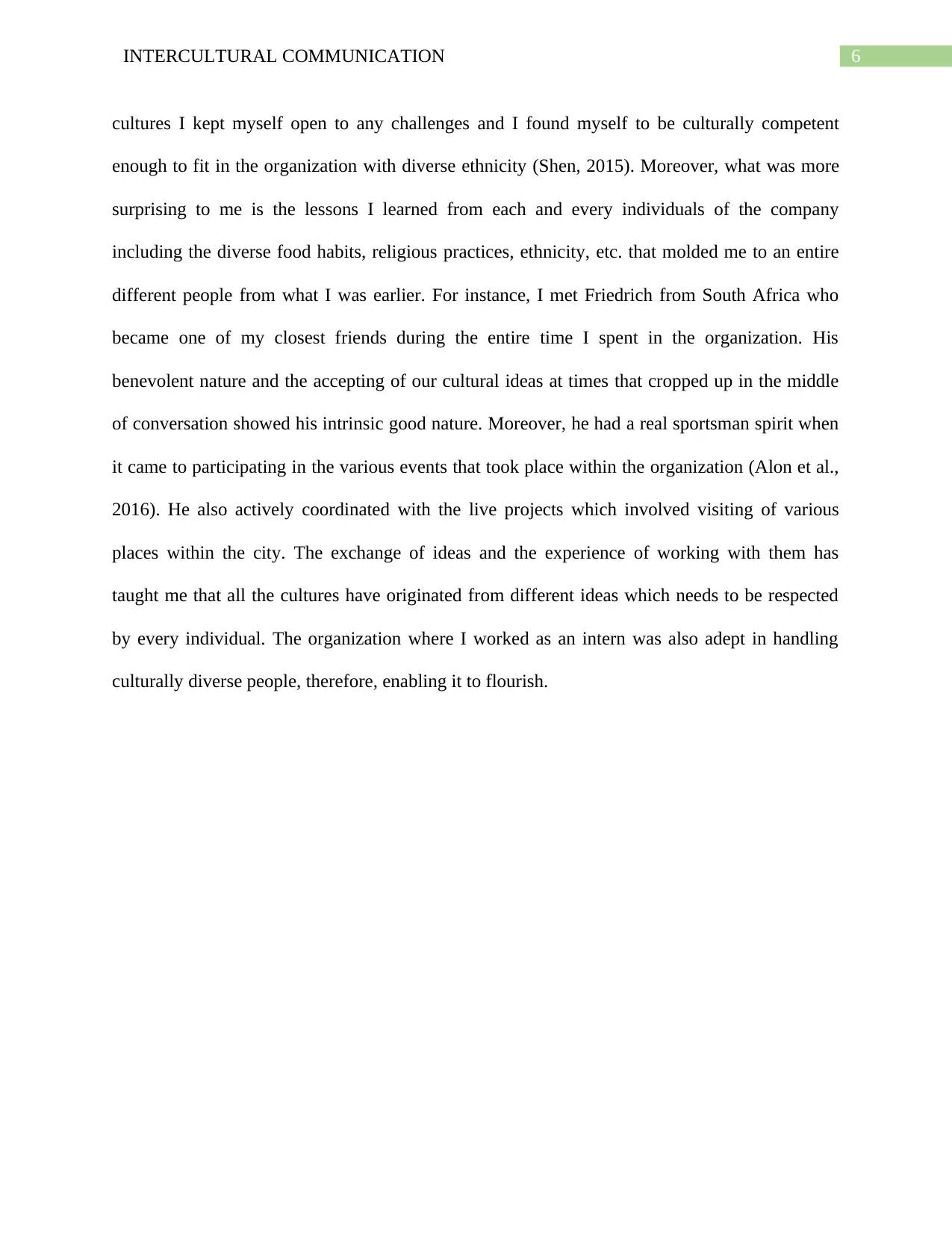
6INTERCULTURAL COMMUNICATION
cultures I kept myself open to any challenges and I found myself to be culturally competent
enough to fit in the organization with diverse ethnicity (Shen, 2015). Moreover, what was more
surprising to me is the lessons I learned from each and every individuals of the company
including the diverse food habits, religious practices, ethnicity, etc. that molded me to an entire
different people from what I was earlier. For instance, I met Friedrich from South Africa who
became one of my closest friends during the entire time I spent in the organization. His
benevolent nature and the accepting of our cultural ideas at times that cropped up in the middle
of conversation showed his intrinsic good nature. Moreover, he had a real sportsman spirit when
it came to participating in the various events that took place within the organization (Alon et al.,
2016). He also actively coordinated with the live projects which involved visiting of various
places within the city. The exchange of ideas and the experience of working with them has
taught me that all the cultures have originated from different ideas which needs to be respected
by every individual. The organization where I worked as an intern was also adept in handling
culturally diverse people, therefore, enabling it to flourish.
cultures I kept myself open to any challenges and I found myself to be culturally competent
enough to fit in the organization with diverse ethnicity (Shen, 2015). Moreover, what was more
surprising to me is the lessons I learned from each and every individuals of the company
including the diverse food habits, religious practices, ethnicity, etc. that molded me to an entire
different people from what I was earlier. For instance, I met Friedrich from South Africa who
became one of my closest friends during the entire time I spent in the organization. His
benevolent nature and the accepting of our cultural ideas at times that cropped up in the middle
of conversation showed his intrinsic good nature. Moreover, he had a real sportsman spirit when
it came to participating in the various events that took place within the organization (Alon et al.,
2016). He also actively coordinated with the live projects which involved visiting of various
places within the city. The exchange of ideas and the experience of working with them has
taught me that all the cultures have originated from different ideas which needs to be respected
by every individual. The organization where I worked as an intern was also adept in handling
culturally diverse people, therefore, enabling it to flourish.
Paraphrase This Document
Need a fresh take? Get an instant paraphrase of this document with our AI Paraphraser
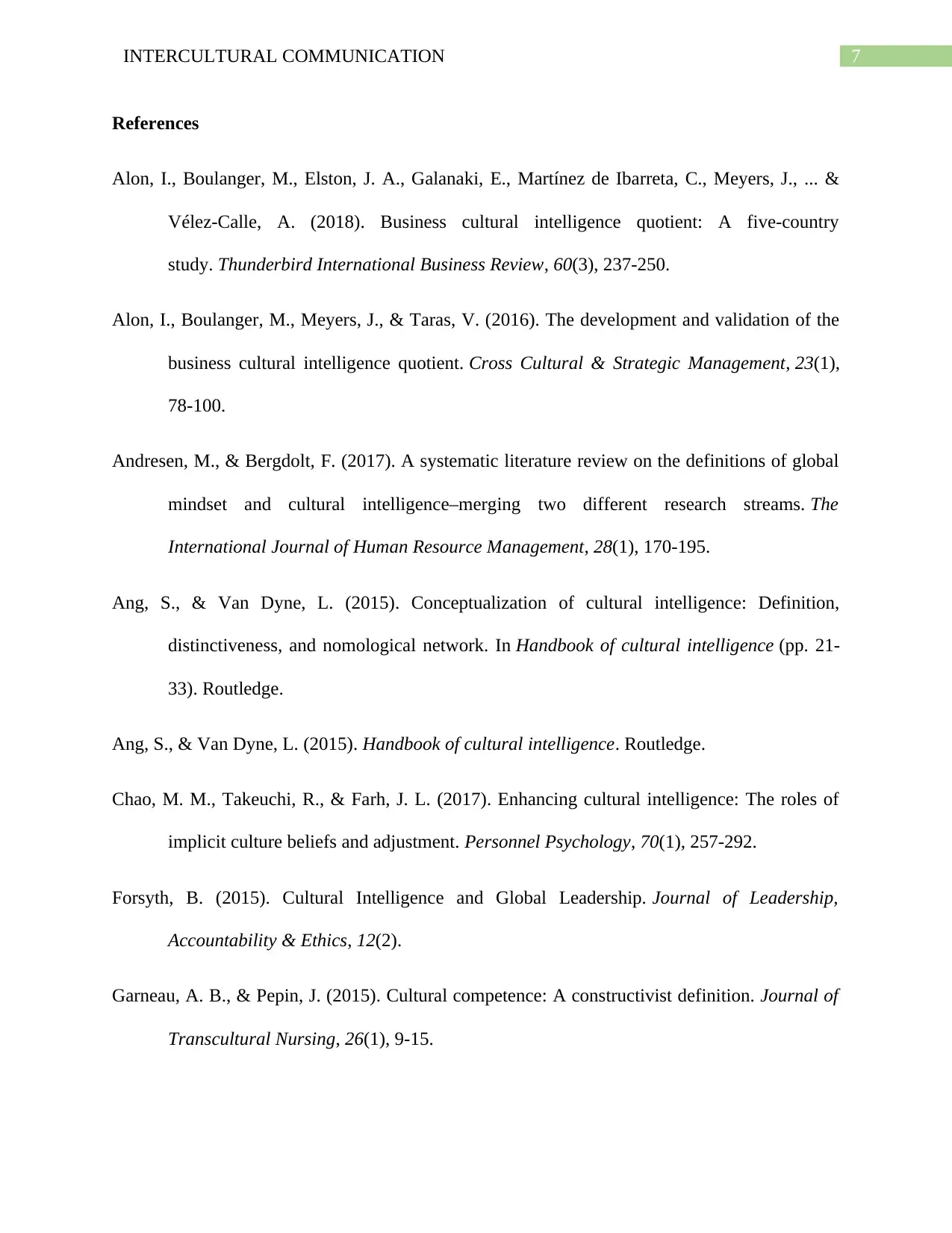
7INTERCULTURAL COMMUNICATION
References
Alon, I., Boulanger, M., Elston, J. A., Galanaki, E., Martínez de Ibarreta, C., Meyers, J., ... &
Vélez‐Calle, A. (2018). Business cultural intelligence quotient: A five‐country
study. Thunderbird International Business Review, 60(3), 237-250.
Alon, I., Boulanger, M., Meyers, J., & Taras, V. (2016). The development and validation of the
business cultural intelligence quotient. Cross Cultural & Strategic Management, 23(1),
78-100.
Andresen, M., & Bergdolt, F. (2017). A systematic literature review on the definitions of global
mindset and cultural intelligence–merging two different research streams. The
International Journal of Human Resource Management, 28(1), 170-195.
Ang, S., & Van Dyne, L. (2015). Conceptualization of cultural intelligence: Definition,
distinctiveness, and nomological network. In Handbook of cultural intelligence (pp. 21-
33). Routledge.
Ang, S., & Van Dyne, L. (2015). Handbook of cultural intelligence. Routledge.
Chao, M. M., Takeuchi, R., & Farh, J. L. (2017). Enhancing cultural intelligence: The roles of
implicit culture beliefs and adjustment. Personnel Psychology, 70(1), 257-292.
Forsyth, B. (2015). Cultural Intelligence and Global Leadership. Journal of Leadership,
Accountability & Ethics, 12(2).
Garneau, A. B., & Pepin, J. (2015). Cultural competence: A constructivist definition. Journal of
Transcultural Nursing, 26(1), 9-15.
References
Alon, I., Boulanger, M., Elston, J. A., Galanaki, E., Martínez de Ibarreta, C., Meyers, J., ... &
Vélez‐Calle, A. (2018). Business cultural intelligence quotient: A five‐country
study. Thunderbird International Business Review, 60(3), 237-250.
Alon, I., Boulanger, M., Meyers, J., & Taras, V. (2016). The development and validation of the
business cultural intelligence quotient. Cross Cultural & Strategic Management, 23(1),
78-100.
Andresen, M., & Bergdolt, F. (2017). A systematic literature review on the definitions of global
mindset and cultural intelligence–merging two different research streams. The
International Journal of Human Resource Management, 28(1), 170-195.
Ang, S., & Van Dyne, L. (2015). Conceptualization of cultural intelligence: Definition,
distinctiveness, and nomological network. In Handbook of cultural intelligence (pp. 21-
33). Routledge.
Ang, S., & Van Dyne, L. (2015). Handbook of cultural intelligence. Routledge.
Chao, M. M., Takeuchi, R., & Farh, J. L. (2017). Enhancing cultural intelligence: The roles of
implicit culture beliefs and adjustment. Personnel Psychology, 70(1), 257-292.
Forsyth, B. (2015). Cultural Intelligence and Global Leadership. Journal of Leadership,
Accountability & Ethics, 12(2).
Garneau, A. B., & Pepin, J. (2015). Cultural competence: A constructivist definition. Journal of
Transcultural Nursing, 26(1), 9-15.
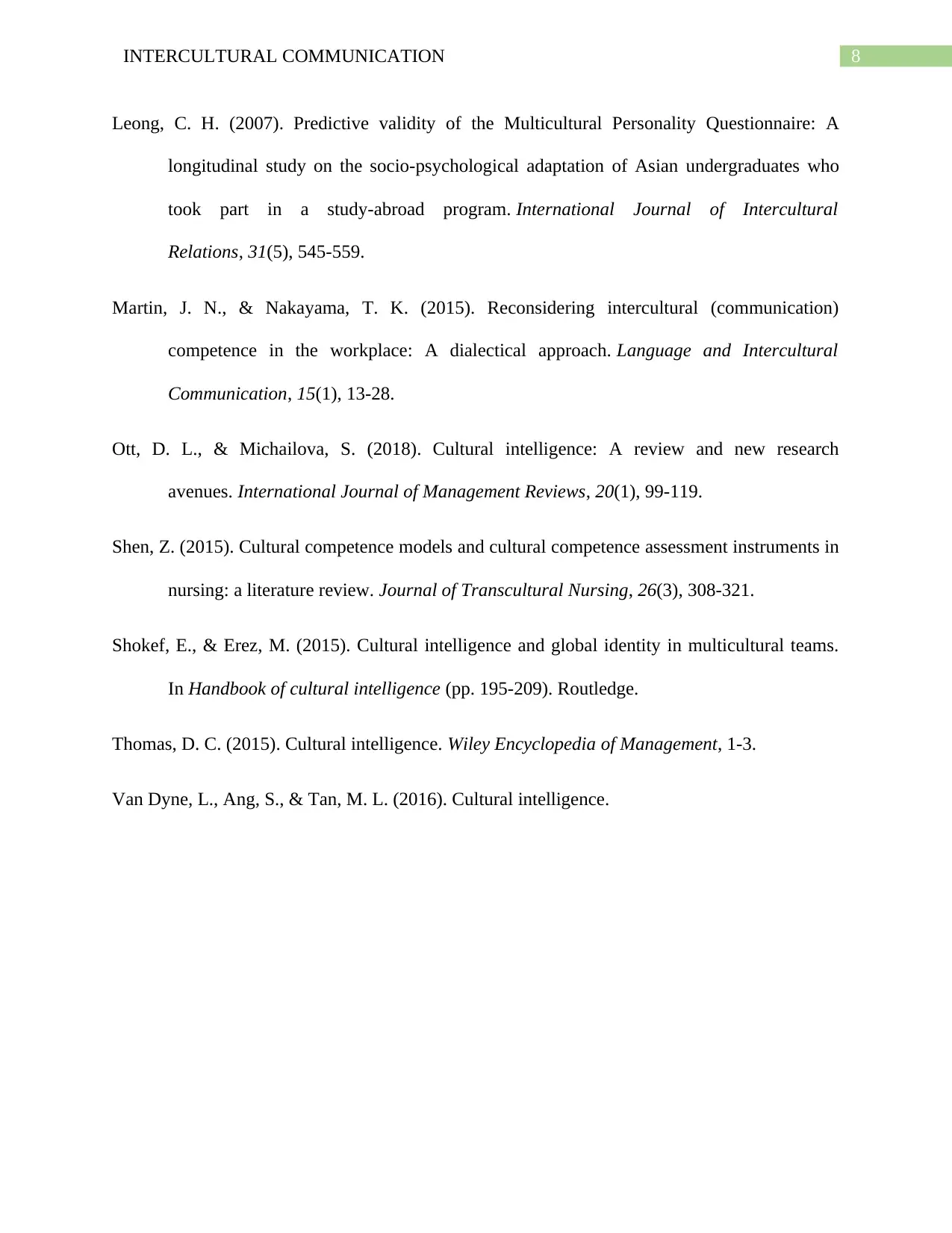
8INTERCULTURAL COMMUNICATION
Leong, C. H. (2007). Predictive validity of the Multicultural Personality Questionnaire: A
longitudinal study on the socio-psychological adaptation of Asian undergraduates who
took part in a study-abroad program. International Journal of Intercultural
Relations, 31(5), 545-559.
Martin, J. N., & Nakayama, T. K. (2015). Reconsidering intercultural (communication)
competence in the workplace: A dialectical approach. Language and Intercultural
Communication, 15(1), 13-28.
Ott, D. L., & Michailova, S. (2018). Cultural intelligence: A review and new research
avenues. International Journal of Management Reviews, 20(1), 99-119.
Shen, Z. (2015). Cultural competence models and cultural competence assessment instruments in
nursing: a literature review. Journal of Transcultural Nursing, 26(3), 308-321.
Shokef, E., & Erez, M. (2015). Cultural intelligence and global identity in multicultural teams.
In Handbook of cultural intelligence (pp. 195-209). Routledge.
Thomas, D. C. (2015). Cultural intelligence. Wiley Encyclopedia of Management, 1-3.
Van Dyne, L., Ang, S., & Tan, M. L. (2016). Cultural intelligence.
Leong, C. H. (2007). Predictive validity of the Multicultural Personality Questionnaire: A
longitudinal study on the socio-psychological adaptation of Asian undergraduates who
took part in a study-abroad program. International Journal of Intercultural
Relations, 31(5), 545-559.
Martin, J. N., & Nakayama, T. K. (2015). Reconsidering intercultural (communication)
competence in the workplace: A dialectical approach. Language and Intercultural
Communication, 15(1), 13-28.
Ott, D. L., & Michailova, S. (2018). Cultural intelligence: A review and new research
avenues. International Journal of Management Reviews, 20(1), 99-119.
Shen, Z. (2015). Cultural competence models and cultural competence assessment instruments in
nursing: a literature review. Journal of Transcultural Nursing, 26(3), 308-321.
Shokef, E., & Erez, M. (2015). Cultural intelligence and global identity in multicultural teams.
In Handbook of cultural intelligence (pp. 195-209). Routledge.
Thomas, D. C. (2015). Cultural intelligence. Wiley Encyclopedia of Management, 1-3.
Van Dyne, L., Ang, S., & Tan, M. L. (2016). Cultural intelligence.
⊘ This is a preview!⊘
Do you want full access?
Subscribe today to unlock all pages.

Trusted by 1+ million students worldwide
1 out of 9
Related Documents
Your All-in-One AI-Powered Toolkit for Academic Success.
+13062052269
info@desklib.com
Available 24*7 on WhatsApp / Email
![[object Object]](/_next/static/media/star-bottom.7253800d.svg)
Unlock your academic potential
Copyright © 2020–2025 A2Z Services. All Rights Reserved. Developed and managed by ZUCOL.





